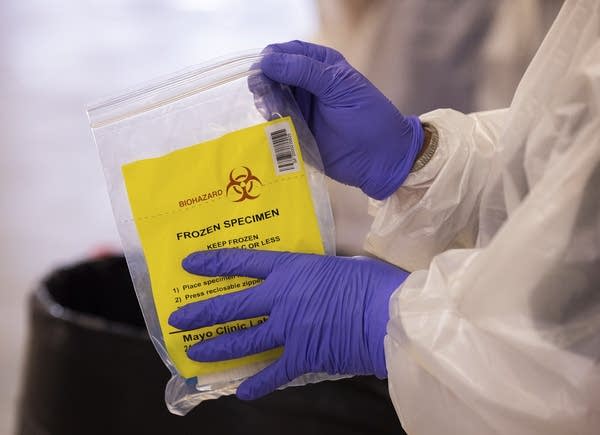Health officials tie northern Minn. COVID-19 surge to everyday gatherings

Go Deeper.
Create an account or log in to save stories.
Like this?
Thanks for liking this story! We have added it to a list of your favorite stories.
Northern Minnesota has hosted two presidential campaign rallies in the past few weeks, during which thousands of people crowded closely together, many of them not wearing masks.
Public health officials have worried those rallies could become COVID-19 super spreader events, and there's still potential that they might, as more testing and contact tracing is done.
But so far, public health officials in northern Minnesota say it's been much smaller get-togethers that seem to be behind the spike in coronavirus cases across the region. Over the past week, northern Minnesota — from the Wisconsin to the North Dakota borders — has averaged the most new cases, relative to its population, in the state.
Kelly Chandler, public health director of Itasca County, said cases have been traced to events like weddings, and to smaller gatherings at bars and restaurants.
Turn Up Your Support
MPR News helps you turn down the noise and build shared understanding. Turn up your support for this public resource and keep trusted journalism accessible to all.
"And then [from there it’s] just a trickle-down,” Chandler said. “It may be an attendee at the event, but then that trickles over to their children, or their worksite, which trickles down to schools."

Over the past week, Itasca County has seen about a 30 percent growth in total positive COVID-19 cases. That's one of the highest jumps in the state.
That jump isn't due to increased testing. When Grand Rapids hosted one of the state's first free COVID-19 testing sites a couple weeks ago, only eight positive cases in the county were identified, a tiny fraction of new cases.
A little farther west, Hubbard County has also experienced one of Minnesota's sharpest upticks in cases over the past week.
Marlee Morrison, community health director for CHI St. Joseph's hospital in Park Rapids, who also works as the county public health director, also attributed case growth to smaller events.
"That's a lot of what we're seeing, is people gathering together with family or friends and then having little outbreaks from those,” she said. “Just these sporadic, family or social events that have spurred quite a few cases.”
The total number of cases in Minnesota’s more rural, less-populated counties since the beginning of the pandemic is still low. Hubbard County for example only has 171 total COVID-19 cases. That’s compared to more than 29,000 in Hennepin County.
County officials and other health experts say the rise in cases can be tied directly to those little decisions and risk calculations people have to make every day: Do I need to wear a mask when I visit with extended family? Should I eat inside a restaurant? Can I go to that potluck?
Many describe it as “pandemic fatigue.”
"Understandably, people want to gather with their family and friends,” said Morrison. “And most of the time, when you're having dinner with your family, you're probably not wearing a mask, and so on. People have let their guard down a little bit."
Andrew Thompson, an infectious disease physician at St. Luke's health system in Duluth, said that seems to be especially true in places like northern Minnesota, which had very low case rates for several months at the beginning of the pandemic, while the Twin Cities and other areas were hit hard by the virus.
"I think, because of the time that we've all had to [adhere to] these precautions, people are getting weary,” Thompson said. “And I think they are not adhering to some of the guidance that we know is going to reduce transmission and reduce disease."
Those precautions include basic steps like wearing a mask, staying 6 feet apart from one another and avoiding large gatherings.
He said he knows of multiple instances in which not following that guidance has resulted in transmission of the virus to older people, who are at higher risk for serious complications from COVID-19.
"Say grandma is being really careful, and only sees a few people in her life. But her grandkids are out gathering at backyard barbecues and may not be as careful. And then that one visitor is able to infect a more vulnerable family member," he said.

That's the nature of this global pandemic, Thompson said. Even people who are really careful are still at risk, because of the people around them.
According to Rajesh Prabhu, an infectious disease doctor at Essentia Health in Duluth, that risk is magnified because people can spread the virus before they show symptoms.
"A lot of these people are getting infected unknowingly, because they don't feel that they're infected and they're passing it on to someone else, which is the reason you're seeing such a high or increased number of cases consistently in the Northland and across the country," he said.
More than six months into the pandemic, the message from public health officials remains the same. To slow the spread of COVID-19, in northern Minnesota and elsewhere, people should wear masks in public, maintain social distance and avoid large gatherings.
That might mean skipping a potluck, or calling grandma instead of visiting her in person.
“But I'm hopeful that in Itasca County,” said county public health director Chandler, “that people will hunker down and not attend as many larger gatherings, and really take the masking and the social distancing seriously. So we can turn this trend around.”
COVID-19 in Minnesota
Data in these graphs are based on the Minnesota Department of Health's cumulative totals released at 11 a.m. daily. You can find more detailed statistics on COVID-19 at the Health Department website.
The coronavirus is transmitted through respiratory droplets, coughs and sneezes, similar to the way the flu can spread.


